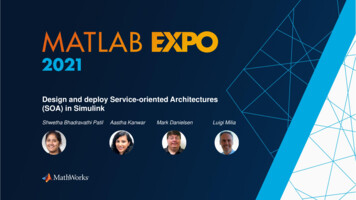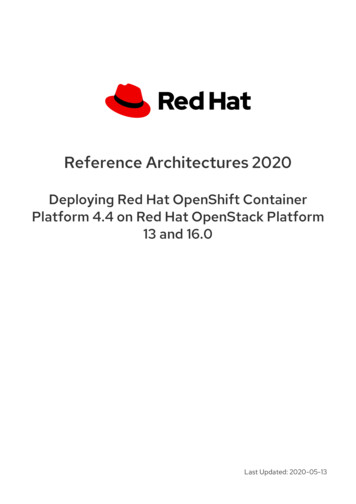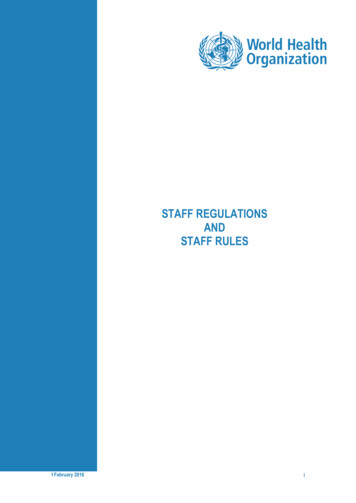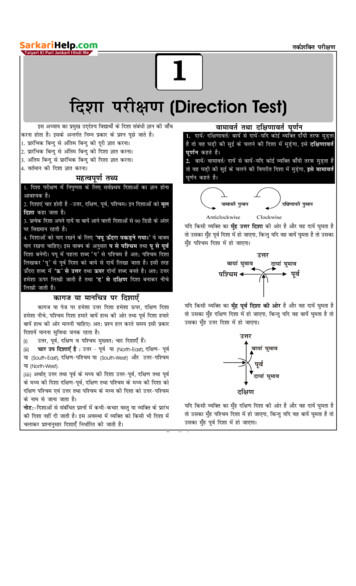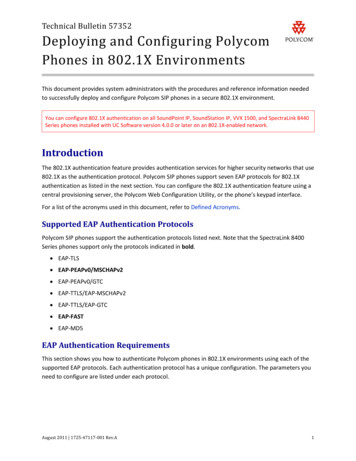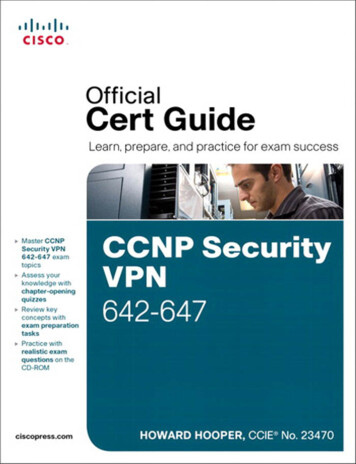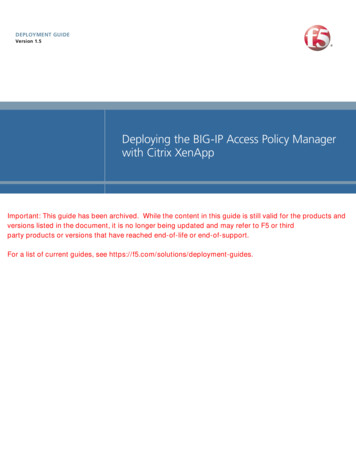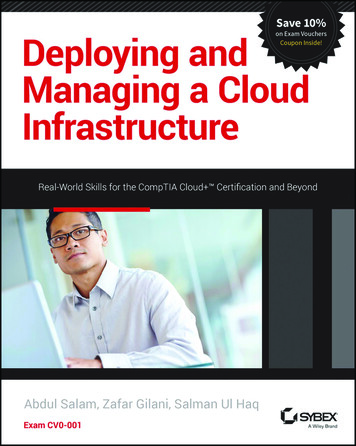
Transcription
Deploying andManaging a CloudInfrastructure
Deploying andManaging a CloudInfrastructureReal World Skills for the CompTIACloud Certification and BeyondZafar GilaniAbdul SalamSalman UI Haq
Acquisitions Editor: Kenyon BrownDevelopment Editor: Tom CirtinTechnical Editor: Kunal MittalProduction Editor: Christine O’ConnorCopy Editor: Judy FlynnEditorial Manager: Pete GaughanProduction Manager: Kathleen WisorAssociate Publisher: Jim MinatelMedia Supervising Producer: Rich GravesBook Designers: Judy Fung and Bill GibsonCompositor: Craig Woods, Happenstance Type-O-RamaProofreader: Kim WimpsettIndexer: Nancy GuentherProject Coordinator, Cover: Patrick RedmondCover Image: WileyCopyright 2015 by John Wiley & Sons, Inc., Indianapolis, IndianaPublished simultaneously in CanadaISBN: 978-1-118-87510-0ISBN: 978-1-118-87529-2 (ebk.)ISBN: 978-1-118-87558-2 (ebk.)No part of this publication may be reproduced, stored in a retrieval system or transmitted in any form orby any means, electronic, mechanical, photocopying, recording, scanning or otherwise, except as permittedunder Sections 107 or 108 of the 1976 United States Copyright Act, without either the prior written permission of the Publisher, or authorization through payment of the appropriate per-copy fee to the CopyrightClearance Center, 222 Rosewood Drive, Danvers, MA 01923, (978) 750-8400, fax (978) 646-8600. Requeststo the Publisher for permission should be addressed to the Permissions Department, John Wiley & Sons, Inc.,111 River Street, Hoboken, NJ 07030, (201) 748-6011, fax (201) 748-6008, or online at http://www.wiley.com/go/permissions.Limit of Liability/Disclaimer of Warranty: The publisher and the author make no representations orwarranties with respect to the accuracy or completeness of the contents of this work and specifically disclaim all warranties, including without limitation warranties of fitness for a particular purpose. No warranty may be created or extended by sales or promotional materials. The advice and strategies containedherein may not be suitable for every situation. This work is sold with the understanding that the publisheris not engaged in rendering legal, accounting, or other professional services. If professional assistance isrequired, the services of a competent professional person should be sought. Neither the publisher nor theauthor shall be liable for damages arising herefrom. The fact that an organization or Web site is referred toin this work as a citation and/or a potential source of further information does not mean that the authoror the publisher endorses the information the organization or Web site may provide or recommendations itmay make. Further, readers should be aware that Internet Web sites listed in this work may have changed ordisappeared between when this work was written and when it is read.For general information on our other products and services or to obtain technical support, please contactour Customer Care Department within the U.S. at (877) 762-2974, outside the U.S. at (317) 572-3993 orfax (317) 572-4002.Wiley publishes in a variety of print and electronic formats and by print-on-demand. Some materialincluded with standard print versions of this book may not be included in e-books or in print-on-demand.If this book refers to media such as a CD or DVD that is not included in the version you purchased, youmay download this material at http://booksupport.wiley.com. For more information about Wileyproducts, visit www.wiley.com.Library of Congress Control Number: 2014951019TRADEMARKS: Wiley, the Wiley logo, and the Sybex logo are trademarks or registered trademarks ofJohn Wiley & Sons, Inc. and/or its affiliates, in the United States and other countries, and may not be usedwithout written permission. Cloud is a trademark of CompTIA Properties LLC. All other trademarksare the property of their respective owners. John Wiley & Sons, Inc. is not associated with any productor vendor mentioned in this book.10 9 8 7 6 5 4 3 2 1
I dedicate this book to my family and my alma maters: NUST, UPC,and KTH.—Zafar GilaniThis book is dedicated to my father and mother, for their kindness anddevotion and for their endless support when I was busy writing this book.Without their prayers and support, it would not have been possible for meto complete this book.—Abdul SalamI dedicate this book to my father. May he live a long and happy life.—Salman Ul Haq
AcknowledgmentsI thank Thomas Cirtin, Kenyon Brown, Christine O’Connor and the rest of Wiley’seditorial team for their important comments and suggestions.—Zafar GilaniI would like to express my gratitude to Ms. Asifa Akram, for her support, patience, andencouragement throughout the project. It is not often that one finds an advisor and friendwho always finds the time to listen to the little problems and roadblocks that unavoidablycrop up in the course of performing research. Her technical advice was essential to thecompletion of this book and has taught me innumerable lessons and insights on the writingof this technical ebook.—Abdul SalamI would like to thank my family for giving me the time and space required to completechapters of this book. The awesome team at Wiley has perfectly managed the executionof this book, especially Thomas Cirtin for reviewing the manuscripts and Jeff Kellum, whoinitially started with the project but is no longer with Wiley. Finally, I would like to thankZafar for keeping everyone engaged.—Salman Ul Haq
About the AuthorsZafar Gilani is a full-time researcher and a PhD candidate at the University of CambridgeComputer Laboratory. Prior to starting his doctoral degree program in 2014, he successfullycompleted his master of science degree in the field of distributed computing. During thattime, he was an Erasmus Mundus scholar at Universitat Politècnica de Catalunya (UPC) andKungliga Tekniska högskolan (KTH) from 2011 to 2013. For his master’s thesis research, heworked on spatio-temporal characterization of mobile web content at Telefonica Research,Barcelona. One of the technological use cases of his research became the basis for developingmobile web content pre-staging for cellular networks.Prior to starting master’s studies, he worked at SLAC National Accelerator Laboratory asa visiting scientist from 2009 to 2011. At SLAC he was involved in the research and development of Internet performance monitoring techniques and applications for geo-location ofIP hosts. He graduated from NUST School of Electrical Engineering and Computer Sciencewith a bachelor of science in computer science in 2009. He worked on providing InfiniBandsupport to MPJ Express (a Java-based MPI-like library) as his bachelor of science thesisresearch work. He can be reached on LinkedIn and at zafar.gilani@cl.cam.ac.uk.Abdul Salam is a senior consultant with Energy Services. He has more than seven yearsof broad experience in cloud computing, including virtualization and network infrastructure. Abdul’s previous experience includes engineering positions at multinational firms.Abdul has authored numerous blogs, technical books and papers, and tutorials as well asweb content on IT. He earned a bachelor degree in information technology followed by amaster of business administration in information technology and technical certificationsfrom Cisco and Juniper Networks. You can contact him at LinkedIn.Salman Ul Haq is a techpreneur and chief hacker at TunaCode. His interest in cloud computing grew when Amazon launched Amazon Web Services (AWS), which ushered in themodern cloud. His core expertise is in building computer vision systems and APIs for thecloud. He is co-inventor of CUVI and gKrypt SDKs. His other interests include big data,especially when combined with advanced AI in the cloud, and data security in the cloud.He can be reached at salman@programmerfish.com.
Contents at a GlanceIntroductionxxiiiChapter 1Understanding Cloud CharacteristicsChapter 2To Grasp the Cloud—Fundamental Concepts27Chapter 3Within the Cloud: Technical Concepts of Cloud Computing53Chapter 4Cloud Management87Chapter 5Diagnosis and Performance Monitoring121Chapter 6Cloud Delivery and Hosting Models157Chapter 7Practical Cloud Knowledge: Install, Configure, and Manage181Chapter 8Hardware Management221Chapter 9Storage Provisioning and Networking245Chapter 10Testing and Deployment: Quality Is King287Chapter 11Cloud Computing Standards and Security323Chapter 12The Cloud Makes It Rain Money: The Business inCloud Computing347Chapter 13Planning for Cloud Integration: Pitfalls and Advantages375AppendixThe CompTIA Cloud Certification Exam397Index1417
ContentsIntroductionChapter 1Chapter 2xxiiiUnderstanding Cloud Characteristics1Basic Terms and CharacteristicsElasticityOn-Demand Self-service/JITTemplatingPay as You GrowPay-as-You-Grow Theory vs. PracticeChargebackUbiquitous AccessMetering Resource PoolingMultitenancyCloud BurstingRapid DeploymentObject Storage ConceptsFile-Based Data StorageObject StorageStructured vs. Unstructured DataREST APIsSummaryChapter Essentials223467891011131416161818192526To Grasp the Cloud—Fundamental Concepts27The True Nature of the CloudElasticMassiveOn DemandVirtualizedSecureAlways AvailableVirtualization and ScalabilityThe True Definer of Cloud ComputingServing the Whole WorldThe Cloud HypervisorType 1 and Type 2Use Cases and ExamplesBenefits of HypervisorsHypervisor Security ConcernsProprietary vs. Open SourceMoore’s Law, Increasing Performance, andDecreasing Enterprise UsageXen Cloud Platform (Open Source)282929293030303132323333343535363637
xiiContentsChapter 3Chapter 4KVM (Open Source)OpenVZ (Open Source)VirtualBox (Open Source)Citrix XenServer (Proprietary)VMware vSphere/ESXi (Proprietary)Microsoft Windows Server 2012 Hyper-VConsumer vs. Enterprise UseWorkstation vs. InfrastructureKey Benefits of Implementing HypervisorsShared ResourcesElasticityNetwork and Application IsolationFoundations of Cloud g ServicesSummaryChapter thin the Cloud: Technical Concepts ofCloud Computing53Technical Basics of Cloud andScalable ComputingDefining a Data CenterTraditional vs. Cloud HardwareDetermining Cloud Data Center Hardwareand InfrastructureOptimization and the Bottom LineThe Cloud InfrastructureOpen SourceProprietarySummaryChapter Essentials65707879848586Cloud Management87Understanding Cloud Management PlatformsWhat It Means for Service ProvidersPlanning Your CloudBuilding Your CloudRunning Your CloudWhat This Means for CustomersService-Level Agreements88909094959597545562
Chapter 5ContentsxiiiPolicies and ProceduresPlanning the Documentation of the Network and IPImplementing Change Management Best PracticesManaging the ConfigurationManaging Cloud WorkloadsManaging Workloads Right on the CloudManaging RiskSecuring Data in the CloudManaging DevicesVirtualizing the DesktopEnterprise Cloud SolutionSummaryChapter gnosis and Performance Monitoring121Performance ConceptsInput/Output Operations per Second (IOPS)Read vs. Write FilesFile System PerformanceMetadata PerformanceCachingBandwidthThroughput: Bandwidth AggregationJumbo FramesNetwork LatencyHop CountsQuality of Service (QoS)MultipathingLoad BalancingScaling: Vertical vs. Horizontal vs. DiagonalDisk PerformanceAccess TimeData Transfer RateDisk TuningSwap Disk SpaceI/O TuningPerformance Management and Monitoring ToolsHypervisor Configuration Best PracticesImpact of Configuration ChangesCommon IssuesSummaryChapter 38138140140142143144144146149151152153154
xivContentsChapter 6Cloud Delivery and Hosting ModelsPrivateFull Private Cloud Deployment ModelSemi-private Cloud Deployment ModelPublicHybridCommunityOn-Premises vs. Off-Premises HostingOn-Premises HostingOff-Premises HostingMiscellaneous Factors to Consider When Choosingbetween On- or Off-Premises HostingComparing Total Cost of OwnershipAccountability and Responsibility Based on Delivery ModelsPrivate Cloud AccountabilityPublic Cloud AccountabilityResponsibility for Service ImpairmentsAccountability CategoriesSecurity Differences between ModelsMultitenancy IssuesData SegregationNetwork IsolationFunctionality and Performance ValidationOn-Premises PerformanceOff-Premises PerformanceTypes of TestingOrchestration PlatformsSummaryChapter EssentialsChapter 7Practical Cloud Knowledge: Install, Configure,and ManageSetting Up the CloudCreating, Importing, and Exporting Templatesand Virtual MachinesCreating Virtual Machine TemplatesImporting and Exporting Service TemplatesInstalling Guest ToolsSnapshots and CloningImage Backups vs. File BackupsVirtual Network Interface CardVirtual DisksVirtual 3184186188189193195198199
ContentsChapter 8Chapter 9xvConfiguring Virtual Machines for Several VLANsVirtual Storage Area NetworkVirtual Resource MigrationEstablishing Migration RequirementsMigrating StorageScheduling MaintenanceReasons for MaintenanceVirtual Components of the CloudVirtual Network ComponentsShared MemoryVirtual CPUStorage VirtualizationSummaryChapter 15Hardware Management221Cloud Hardware ResourcesBIOS/Firmware ConfigurationsMinimum Memory Capacity and ConfigurationNumber of CPUsNumber of CoresNIC Quantity, Speeds, and ConfigurationsInternal Hardware CompatibilityStorage MediaProper Allocation of Hardware Resources (Host)Proper Virtual Resource Allocation (Tenant/Client)Management Differences between Public, Private,and Hybrid CloudsPublic Cloud ManagementPrivate Cloud ManagementHybrid Cloud ManagementTieringPerformance Levels of Each TierPoliciesRAID LevelsFile SystemsSummaryChapter Essentials222222223223224225225226227232Storage Provisioning and NetworkingCloud Storage ConceptsObject 9241242245246246247248
xviContentsExtended MetadataReplicasPolicies and Access ControlUnderstanding SAN and NASCloud vs. SAN StorageCloud StorageAdvantages of Cloud StorageCloud ProvisioningMigrating Software Infrastructure to the CloudCloud Provisioning Security ConcernsStorage ProvisioningNetwork ConfigurationsNetwork OptimizationCloud Storage TechnologyData ReplicationAmazon Elastic Block Store (EBS)Amazon Simple Storage Service (S3)OpenStack SwiftHadoop Distributed File System (HDFS)Choosing from among These TechnologiesCloud Storage GatewayCloud Security and PrivacySecurity, Privacy, and Attack Surface AreaLegal Issues (Jurisdiction and Data)Supplier Lifetime (Vendor Lock-In)SummaryChapter EssentialsChapter 10Testing and Deployment: Quality Is KingOverview of Deployment ModelsPrivate CloudCommunity CloudPublic CloudHybrid CloudCloud Management StrategiesPrivate Cloud StrategiesCommunity Cloud StrategiesPublic Cloud StrategiesHybrid Cloud StrategiesManagement ToolsCloud ArchitectureThe Need for Cloud ArchitecturesTechnical BenefitsBusiness 9289290290291291292292293294294295295
ContentsCloud Deployment OptionsEnvironment ProvisioningDeploying a Service to the CloudDeployment Testing and MonitoringCreating and Deploying Cloud ServicesCreating and Deploying a Cloud ServiceUsing Windows AzureDeploying and Managing a Scalable Web Servicewith Flume on Amazon EC2SummaryChapter EssentialsChapter 11Cloud Computing Standards and SecurityCloud Computing StandardsWhy Do Standards Matter?Current Ad Hoc StandardsSecurity Concepts and ToolsSecurity Threats and AttacksObfuscationAccess Control ListVirtual Private NetworkFirewallsDemilitarized ZoneEncryption TechniquesPublic Key InfrastructureInternet Protocol SecuritySecure Sockets Layer/Transport Layer SecurityCiphersAccess Control MethodsRole-Based Access ControlMandatory Access ControlDiscretionary Access ControlRule-Based Access ControlsMultifactor AuthenticationSingle Sign-OnFederationImplementing Guest and Host Hardening TechniquesDisabling Unneeded Ports and ServicesSecure User CredentialsAntivirus SoftwareSoftware Security PatchingSummaryChapter 9339339339340340340343344344345345
xviiiContentsChapter 12Chapter 13The Cloud Makes It Rain Money: The Businessin Cloud Computing347The Nature of Cloud BusinessThe Service Nature of the CloudMaking Money with Open-Source SoftwareWhite Label BrandingCloud Service Business ModelsInfrastructure as a Service (IaaS)Platform as a Service (PaaS)Software as a Service (SaaS)Data as a Service (DaaS)Communication as a Service (CaaS)Monitoring as a Service (MaaS)Business Process as a Service (BPaaS)Anything as a Service (XaaS)Service Model Accountability and ResponsibilityThe Enterprise CloudEnterprise ApplicationsCloud CollaborationCollaborating with TelepresenceDisaster RecoveryPreparing for Failure: Disaster Recovery PlanBackup Sites and Geographical DiversityChange-Over Mechanism: Failover and FailbackBusiness Continuity and Cloud ComputingBusiness Continuity in the CloudWorkshifting in the CloudBring Your Own DeviceSummaryChapter ng for Cloud Integration: Pitfallsand Advantages375Work OptimizationOptimizing Usage, Capacity, and CostWhich Service Model Is Best for You?The Right Cloud ModelPrivate CloudPublic CloudHybrid Cloud376376379381381383384
ContentsAdapting Organizational Culture for the CloudFinding Out the Current CultureMapping Out an Adaption PlanCulture Adaption, Propagation, and MaintenancePotholes on the Cloud RoadRoadblocks to PlanningConvincing the BoardSummaryChapter 394The CompTIA Cloud Certification Exam397Preparing for the ExamTaking the ExamReviewing the Exam Objectives398399400417
Table of ExercisesExercise 1.1JIT Provisioning on AWS . . . . . . . . . . . . . . . . . . . . . . . . . . . . . . . . . . . . . . . . 5Exercise 7.1Creating a Template from a Virtual Machine in Microsoft VMM . . . . . . 184Exercise 7.2Creating a Template from Virtual Disks . . . . . . . . . . . . . . . . . . . . . . . . . . 186Exercise 7.3Exporting Service Templates in Microsoft VMM . . . . . . . . . . . . . . . . . . . 187Exercise 7.4Importing Service Templates in Microsoft VMM . . . . . . . . . . . . . . . . . . . 187Exercise 7.5Creating Snapshots . . . . . . . . . . . . . . . . . . . . . . . . . . . . . . . . . . . . . . . . . . . 190Exercise 7.6Creating Clones . . . . . . . . . . . . . . . . . . . . . . . . . . . . . . . . . . . . . . . . . . . . . . 191Exercise 9.1Adding, Removing, and Reading Data from HDFS . . . . . . . . . . . . . . . . . 270Exercise 9.2Killing a Hadoop Job and Avoiding Zombie Processes . . . . . . . . . . . . . . 271Exercise 9.3Resolving a Common IOException with HDFS . . . . . . . . . . . . . . . . . . . . . 271Exercise 9.4Using Pig to Group and Join Items Based on Some Criteria . . . . . . . . . 276
It Pays to Get CertifiedIn a digital world, digitalliteracy is an essentialsurvival skill.Certification demonstratesthat you have the knowledgeand skill to solve technical orbusiness problems in virtuallyany business environment.Certifications are highly valuedcredentials that qualify you forjobs, increased compensation,and promotion.CompTIA Cloud certification designates an experienced IT professional equipped to provide secure technical solutions to meet businessrequirements in the cloud. Certifies that the successful candidate has the knowledge and skillsrequired to understand standard cloud terminologies and methodologies to implement, maintain, and support cloud technologies andinfrastructure.Job roles include System Administrator, Network Administrator and Storage Administrator among many others.The market for cloud related jobs is growing with annual cloud market growth of almost 30% projected byresearch group IDC over the next several years. Steps to Getting Certified and Staying CertifiedReview the certification objectives to make sure you know what is covered in the exam. pxReview ExamObjectivesAfter you have studied for the certification, take a free assessment andsample test to get an idea of what type of questions might be on the exam.Practice forthe ns.aspxPurchase anExam VoucherPurchase your exam voucher on the CompTIA Marketplace, which islocated at: http://www.comptiastore.com/Take the TestSelect a certification exam provider and schedule a time to take yourexam. You can find exam providers at the following tingcenters.aspxStay Certified!ContinuingEducationThe CompTIA Cloud certification is valid for three years from the date ofcertification. There are a number of ways the certification can be renewed.For more information go tayCertified.aspxHow to Obtain More InformationVisit CompTIA onlinewww.comptia.org to learn more about getting CompTIA certified.Contact CompTIA Call 866-835-8020 ext. 5 or email questions@comptia.org.Connect with usWe’re on LinkedIn, Facebook, Twitter, Flickr, and YouTube.
IntroductionCloud computing is reality now, defining how IT is handled not only in large, medium, andsmall enterprises but also in—consumer—facing businesses. The cloud itself is a familiarcliché, but when you attach computing, it brings with it a slew of services, vendors, and such,and the horizon includes virtual server providers, hosting providers, virtual storage and networking providers, hypervisor vendors, and private/public cloud providers.The enterprise IT landscape has always been well-defined and segmented. Cloud computing initially started with replacing the traditional IT model; any business that had anything to do with computers and software (and that was almost 100 percent of businessesaround the world) would need to acquire physical servers (often racks of them, dependingon the size of the business) and storage and networking components. The business thenhad to construct a specially designed data center to deploy the components then configure,support, and manage the data center. Specialized IT skills were needed for executing adata center and managing it. Only large-scale enterprises and well-funded businesses couldafford to undertake this. Even for large enterprises that had their own massive data centersfor distributing enterprise applications to the workers and storing business data, operatingthe data center itself was a distraction that added to costs.Cloud computing is a natural transition from this legacy model of enterprise IT to aworld where computing can be sold and purchased just like any other commodity, whereconsumers would pay only for what they use, without steep up-front bills. You can now“order” 100 virtual servers and build enough computing capacity to run an applicationconsumed by 100 million users over the Internet without owning a single server or writinga huge check to cover up-front costs. The cloud has not only ushered in a new age for enterprise IT, it has become the enabler technology for the Internet startups of today. It wouldbe safe to say that a lot of very well-known Internet businesses wouldn’t be possible if therewere no cloud.Who Should Read This BookThe global cloud market is expected to reach 270 billion by 2020. With most governmentand corporate IT moving into the cloud, this is the perfect time to equip yourself with theright skills to thrive in cloud computing.Even though cloud computing has significantly lowered the barrier for businesses to useIT resources on demand, this does not mean that you can create your company’s virtualdata center in the cloud with just a few clicks. Building the right cloud infrastructure andefficiently managing and supporting it requires specialized skills. In addition to cloud practitioners, this book is for IT students who want to take a dive into understanding the conceptsbehind some of the key technologies that power modern cloud solutions and are essential fordeploying, configuring, and managing private, public, and hybrid cloud environments.Additionally, the topics covered in this book have been selected to address the CompTIACloud certification CV0-001, as indicated in the title of the book.
xxivIntroductionIf you’re preparing for the CompTIA Cloud certification CV0-001, this book is idealfor you. You can find more information about the CompTIA Cloud certification /certifications/cloudplus.aspxHow This Book is OrganizedThe topics in this book were chosen to cover a wide range of cloud technologies, deployment scenarios, and configuration issues as well as fundamental concepts that define moderncloud computing. Every chapter begins with an introduction and a list of the topics coveredwithin it. To enhance your learning experience, we’ve included hands-on exercises and realworld scenarios. The book also includes a practice exam that covers the topics presented ineach chapter, which will help you prepare well for the certification exam.Chapter 1, “Understanding Cloud Characteristics,” starts off with a detailed overview ofthe key terms related to cloud computing, including discussions of elasticity, metering/billingwith the pay-as-you-grow model, network access, multitenancy, and a hybrid cloud scenariowith cloud bursting, rapid deployment, and automation. The chapter also covers key conceptsin object-based storage systems, including object IDs, metadata, access policies, and enablingaccess through REST APIs.Chapter 2, “To Grasp the Cloud—Fundamental Concepts,” takes a dive into the key pieceof technology that makes it possible to enable cloud computing—virtualization. This chaptercovers Type 1 and Type 2 hypervisors and their differences plus popular open-source and proprietary hypervisors that are available today with an overview of their key features. It also covers consumer versus enterprise use cases and workstation versus infrastructure virtualization.We discuss the key benefits of virtualization, like shared resources, elasticity, and completeresource pooling, including compute, storage, and network. The chapter ends with a discussion of the fundamentals of cloud computing in the context of virtualization technology.Chapter 3, “Within the Cloud: Technical Concepts of Cloud Computing,” takes a diveinto the technical aspects of scalable computing, which include a comparison of traditionaland cloud infrastructures, selecting the right infrastructure for building your own cloud,scaling and optimizing a data center, and economies of scale. At the end of the chapter,there’s a section on cloud infrastructure, which covers open-source and proprietary solutions and includes a discussion on choosing between creating in-house tools or selectingthird-party solutions and what drives the build versus buy decisions when it comes tocloud infrastructure.Chapter 4, “Cloud Management,” includes a plethora of scenarios, use cases, and issuesassociated with managing deployment and ongoing support for your cloud implementation.Broadly, this includes managing your own cloud, managing workloads in the cloud, andmanaging business data assets that live in the cloud, including data migration and securestorage and access of the data. The cloud is device agnostic, so controlling and managingaccess to the cloud by a plethora of devices—a concept known as BYOD—is also discussed.
IntroductionxxvChapter 5, “Diagnosis and Performance Monitoring,” discusses the aspects of a cloudimplementation that you’ll want to gauge and monitor. This includes performance metricsacross compute (e.g., IOPS and load balancing), network (e.g., latency and bandwidth), andstorage (e.g., file system performance and caching) resources. We also discuss best practicesto achieve optimal performance with the hypervisor and common failure scenarios.Chapter 6, “Cloud Delivery and Hosting Models,” dives into the three main types of cloudsin terms of delivery and access: public, private, and hybrid. On-premise and off-premise hosting options are discussed for all three types. At the end of the chapter is a discussion of thesecurity and functionality aspects of these models.Chapter 7, “Practical Cloud Knowledge: Install, Configure, and Manage,” provideshands-on practical knowledge of the intricacies of setting up and managing your owncloud infrastructure. The chapter includes key discussions on creating a complete virtualized data center and configuring virtual compute, storage, and networking components.We’ll discuss migrating existing data and compute workloads to a newly built cloud andprovide an overview of the key virtual components of the cloud.Chapter 8, “Hardware Management,” walks through the physical hardware componentsthat make up a cloud. Pros and cons of hardware design choices are discussed, including compute (e.g., number of cores and parallelism), storage (e.g., magnetic/spinning disk versus SSD),and networking (e.g., NIC quantities, types, and speed). Toward the end of the chapter, there’san in-depth discussion of cloud storage options.Chapter 9, “Storage Provisioning and Networking,” dives deep into creating virtualizedstorage, managing storage security and access, and provisioning models. We’ll show youhow to configure networking for the cloud, including how to create and configure multiplevir
Contents at a Glance Introduction xxiii Chapter 1 Understanding Cloud Characteristics 1 Chapter 2 To Grasp the Cloud—Fundamental Concepts 27 Chapter 3 Within the Cloud: Technical Concepts of Cloud Computing 53 Chapter 4 Cloud Management 87 Chapter 5 Diagnosis and Performance Monitoring 121 Chapter 6 Cloud Delivery and Hosting Models 157 Chapter 7 Practical Cloud Knowledge: Install, Configure .

